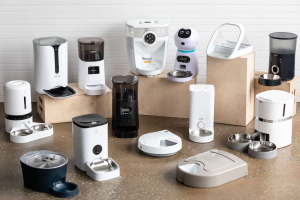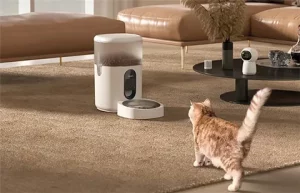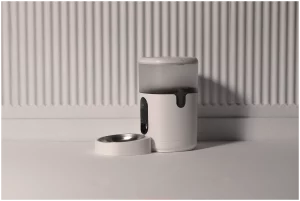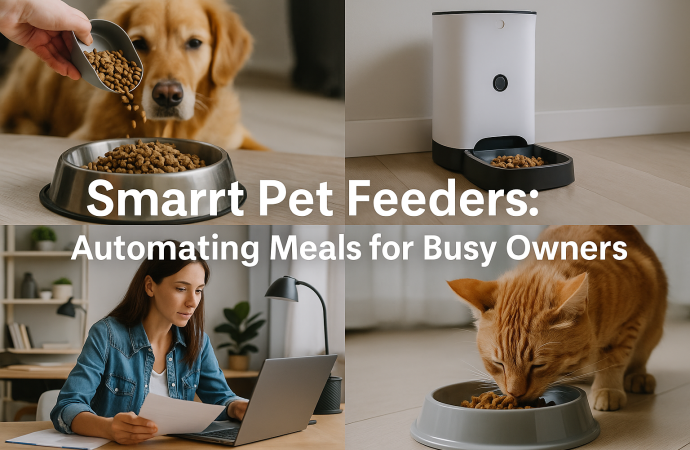What Are Smart Pet Feeders? Smart pet feeders are small countertop machines that hold dry or wet food, measure set portions, and release meals on a schedule you control from a phone app. Built-in motors turn an internal wheel, dropping kibble into a bowl at exact times. Sensors confirm each portion, while Wi-Fi or Bluetooth
What Are Smart Pet Feeders?
Smart pet feeders are small countertop machines that hold dry or wet food, measure set portions, and release meals on a schedule you control from a phone app. Built-in motors turn an internal wheel, dropping kibble into a bowl at exact times. Sensors confirm each portion, while Wi-Fi or Bluetooth radios send updates so you know the feeder worked. If a power cut hits, most models switch to batteries to keep your pet fed until you get home. In short, they replace guesswork and let owners manage nutrition with the same ease as a calendar reminder.
Main Features in Today’s Models
Modern feeders include high-precision scales, jam-proof chutes, sealed hoppers that keep food fresh, and voice recorders so pets hear a familiar call at dinner. Many also pair with cameras, letting you watch pets eat or record short clips for fun. This mix of hardware and software turns mealtime into a predictable, data-rich event instead of a hurried scoop-and-pour routine.
Why 2025 Is a Breakthrough Year
Global demand has pushed the automatic and smart pet feeder market from $1.72 billion in 2024 to an expected $1.98 billion in 2025, a jump driven by busy households and better technology. Analysts forecast the category will hit $2.35 billion by 2030, growing at 8.46 percent a year as new sensors and AI enter the mix. Owners who adopted pets during lockdowns now work hybrid jobs, so reliable feeding tools feel less like a luxury and more like peace of mind.
The Core Technology Explained

Image by: Yandex.com
Portion-Control Systems
Inside every feeder is a rotating drum or conveyor paired with an optical or weight sensor. When you set a 70-gram portion, the motor spins until the sensor confirms the exact mass. Consistency prevents overfeeding, cutting obesity risk and vet bills.
Connected Apps and Cloud Logs
Apps show daily intake graphs, send refill alerts, and let you trigger an extra snack from the office. Some brands, such as WOPET, even estimate calories based on breed and age, adjusting future meals automatically.
Backup Power and Safety Nets
Better feeders ship with dual-power design—plug plus batteries. Petlibro’s Granary line, for instance, keeps running on three D-cells if the lights go out. Locking lids stop curious paws, and slow-decline dispensers prevent jams that could leave a pet hungry.
Benefits for Pets and People
Reliable timing means pets eat at the same hour every day, stabilizing blood sugar and digestion. Measured portions curb begging and midnight yowls. Owners gain freedom: no rushing home at 6 p.m., no early-morning alarms on weekends. Remote feeding also helps manage multi-pet households; microchip-linked bowls like SureFeed only open for the right pet, ending food theft and diet conflicts. Finally, data logs become a health diary, alerting you if a cat suddenly skips meals—an early sign of illness.
Comparing Leading Models in 2025
| Brand & Model | Capacity | Unique Edge | Typical Price (USD) | |
|---|---|---|---|---|
| Petlibro Granary | 4 L | Triple anti-clog design, voice call feature | ||
| SureFeed Microchip Connect | 0.4 L | Opens only for registered pet’s chip, ideal for special diets | 199–229 | |
| WOPET Wi-Fi SmartFeeder | 6 L | App with calorie advice, optional HD camera | 139–169 |
These three represent the main branches of the market: general multi-pet, microchip-controlled, and high-capacity camera-enabled.
Choosing the Right Feeder
First, match capacity to pet size and refill habits. A six-liter hopper lasts a labrador three days; a two-liter unit can feed a single cat for over a week. Second, weigh feature value. Camera add-ons cost more but reassure owners who like visual check-ins. Third, test app usability. Download the companion app before buying and browse reviews for crashes or missing alerts. Fourth, if you have several pets, select either a chip-controlled lid or schedule meals in separate rooms to prevent guarding behaviors.
Budget Considerations
Smart pet feeders range from budget to premium. Entry-level models start around sixty dollars. Mid-range devices cost between one hundred and two hundred dollars. High-end feeders with cameras and cellular backup can exceed two hundred fifty dollars. Balance features with cost to find the best value.
Setup Tips for Smooth Adoption

Image by: Yandex.com
Place the feeder on a flat, non-slip mat in your pet’s regular eating spot. For the first week, let the device drop a small treat so the motor sound links to rewards. Gradually replace old bowls once the pet walks over without hesitation. Clean interiors monthly with mild soap and warm water, following each brand’s guide. Dry thoroughly; moisture can gum up kibble and sensors.
Solving Common Problems
If kibble jams, switch to smaller or rounder pieces—some machines list a maximum diameter. An unexpected Wi-Fi drop usually traces back to a crowded 5 GHz network; most feeders prefer 2.4 GHz. Move the router closer or add a signal extender. Should portions look inconsistent, recalibrate the scale in the app and confirm the feeder sits level.
Future Trends to Watch
AI-Driven Adaptive Feeding
Brands are testing learning algorithms that study pace and leftover amounts, then tweak future portions automatically. This approach mirrors human smart thermostats—set once, then let data refine performance.
Integration With Wearables
Collars that track activity and sleep can soon send calorie recommendations straight to the feeder. If a dog runs extra kilometers, supper adjusts upward without owner input.
Sustainability Moves
Expect hoppers made from recycled plastics and power-usage data in app dashboards. Some firms plan return-and-refill kibble cartridges to cut packaging waste.
Subscription Food Services
Feeder makers partner with premium food brands, shipping pre-portioned packs that clip into the dispenser. Owners skip store trips, and pets enjoy consistent freshness.
Tips for Finding Deals

Image by: Yandex.com
Peak sales drop during spring pet-tech expos and November shopping weeks. Setting price alerts in vendor apps can shave 15 percent. Bundles that pair feeders with fountains often cost less than buying items solo.
The Human Side of Pet Tech
Critics warn that gadgets risk replacing attention with automation. Yet a Financial Times report notes most owners still view devices as helpers, not substitutes, for walks and play. In fact, fewer missed meals and steadier routines can free owners to spend quality, stress-free time with their animals.
Conclusion
Smart pet feeders have shifted from novelty to necessity for many households in 2025. By combining precise portion control, reliable scheduling, and real-time updates, they solve the daily puzzle of balanced nutrition when life pulls owners away. As AI, wearables, and sustainable materials shape the next generation, automated feeders will grow even smarter and greener—making healthy, on-time meals the easiest part of pet care.
Ready to give your cat or dog a clockwork-perfect dinner? Compare the top feeders above, pick the features that match your lifestyle, and enjoy the calm that comes from knowing every meal is handled—even when you are not there.
















